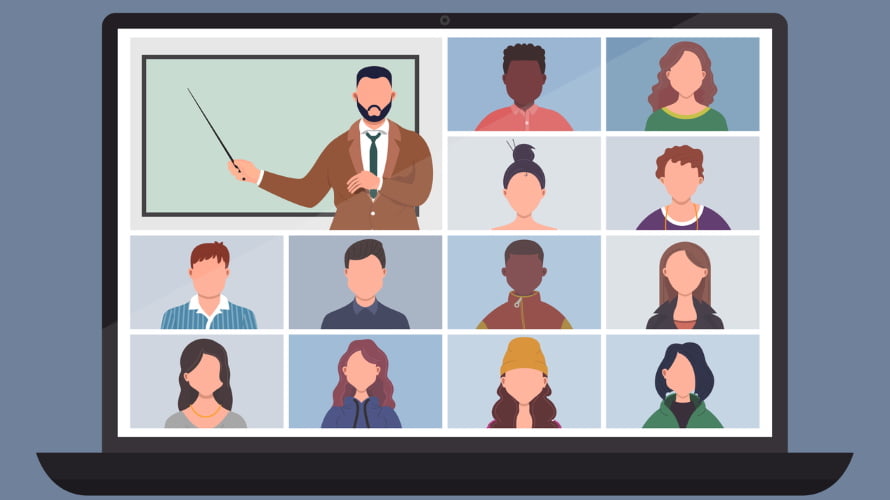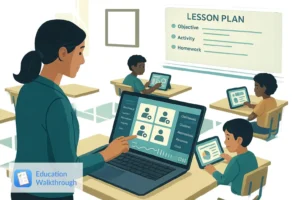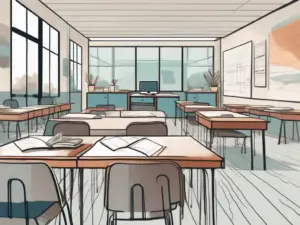If you are like most school administrators, you have little to no experience supervising virtual classrooms. In a “normal” year, being an instructional leader involves being physically present in classrooms. It involves “walking through” classrooms to observe instruction, talk with students, and provide feedback to teachers on instructional practice. Over the past year, you likely struggled with how to effectively monitor instruction in a virtual environment. How do you “walk around” and observe virtual class meetings that are happening simultaneously across the day? How do you “observe” the instructional practices of teachers and find ways to gauge student understanding?
This fall, many schools are planning for in-person instruction. However, most continue to offer a virtual option, and as we move through the coming months, in-person instruction may shift to virtual in response to COVID-19 cases in the community. This shift has already started in some southern states, where the delta variant is surging (US News, Aug. 11, 2021). In addition, many of the virtual tools implemented last year out of necessity are here to stay. Learning management systems, virtual programs that personalize learning, or products that engage students in learning through the use of multimedia and built-in opportunities to respond are not going anywhere. So, as instructional leaders, we must learn how to monitor learning in a 21st Century classroom.
Walking Through the Virtual Classroom
Whether your school is 100% online, or your teachers are using virtual tools to support students who are in quarantine, you should outline a plan for monitoring virtual instruction. These are some questions to ask as you plan:
- What will you target during the “walkthrough”? What is it that you are looking for?
- How will you actually conduct a “walkthrough” in a virtual classroom? How will you document your observations?
- How will you use results from these “walkthroughs” to improve teacher practice and student achievement?
These are the same questions that administrators should be asking for in-person walkthroughs. The answers, however, are different when thinking about monitoring the virtual classroom.
Instructional Targets in the Virtual Classroom
Over the past year, teachers have shifted (sometimes overnight) from providing instruction in face-to-face classroom environments to providing virtual instruction. On the whole, they have done an extraordinary job, and administrators should continue to provide encouragement and praise to teachers who are faced with learning new formats for instruction and using new technology tools. As you think about how to monitor instruction and engage in a virtual walkthrough process, it is vital that you remember the shifts teachers have made and are continuing to make in their professional practice.
McWilliams (2020) recommends collaborative conversations between teachers and administrators to identify growth goals for professional practice as teachers learn to instruction in a virtual format. Talk with your teachers regarding what they would like to learn this year. Is your district implementing a new Learning Management System? Are you implementing new tools such as Nearpod? Allow teachers to identify something they want to learn how to use, and then set a target to “walkthrough” and observe their use of the new tool.
Setting goals with individual teachers may mean that your targets for walkthroughs differ for teachers, and that is okay. If your school or district is focused on implementing a specific tool or a specific format for virtual instruction, you would have a similar target for all teachers—your walkthroughs would focus on observing the implementation of that tool or format.
Conducting Virtual Walkthroughs
It is this question where the differences between in-person and virtual walkthroughs are most pronounced. While you might not be able to physically visit a teachers’ classroom, there are ways to “visit” a virtual classroom. Leonard (2021) points out several ways that virtual schools have monitored online learning: monitoring student grades, teacher participation in the class, activity, and attendance for both students and teachers. These things can be monitored by pulling reports from your Learning Management System (LMS) or Student Information System (SIS).
While pulling activity reports gives you some sense of the engagement in a virtual class, these reports do not help you “see” instruction as you would during a traditional walkthrough. When my school closed temporarily last year in response to increasing COVID numbers, I was able to use these additional methods to “walkthrough” classrooms and monitor instruction.
- Visit Virtual Classrooms Using a Student View
Most Learning Management Systems allow administrators to access all courses that are available in the school. For example, I can “visit” the online classrooms of all of my teachers, and I can view the course as a student. This allows me to “walk around” in the course as if I were a student experiencing the learning. When our school was 100% virtual for a few weeks, I spent a large portion of my day visiting classrooms this way. I was able to see how the tasks for the week were organized and even engage in the learning tasks myself.
- Continue to View Lesson Plans
In the 21st Century, it is my hope that your teachers are not still turning in paper copies of lesson plans. If they are, it’s time to shift to a method for them to share those electronically. Since our school is already sharing lesson plans through a shared Google drive, I could continue to view weekly lesson plans even though we shifted to virtual instruction. I monitored standards-based planning, research-based strategies, and even collaborative planning by reviewing lesson plans before “visiting” virtual classrooms. While reviewing the tasks and activities available for students in virtual classrooms, I could refer back to lesson plans to ensure that instruction was linked to learning standards.
- Join Virtual Class Meetings (Sometimes)
You may be thinking that you can monitor instruction by creating a schedule and spending your day joining virtual class meetings. While it is a great way to continue to connect with students and teachers, I have found that this doesn’t give a full picture of instruction. While our students were virtual, class meetings often became a time for teachers to engage in social-emotional learning with students. Well-planned lessons were short-lived, as students began to notice their friends, wave to them, and try to share and talk with the teacher and their classmates. Recognizing that our students needed this time for social connection, teachers formatted live lessons in this way:
- Time for a class meeting to share and connect.
- Time for the teachers to introduce or review the learning tasks available in the virtual classroom and what students should be working on.
- Time for students to ask questions about the learning tasks.
- Most students dismissed to work on tasks—teacher remains to help any students who have additional questions (or sometimes who just want to talk with her and connect).
I found that to get a true picture of instruction, I could visit the class meetings occasionally to see how teachers were providing social-emotional learning or a positive environment. I might also get a sense of how the teacher was able to set learning targets or introduce standards. But, to get a full picture of instruction, I had to also visit the virtual classrooms and dig in to the learning tasks there.
Using Results to Improve Teacher Practice and Student Learning
As with traditional walkthroughs, they are only effective as a professional practice if you do something with the results. This year, administrators should focus on how virtual walkthroughs can help improve teacher use of virtual tools. Are you noticing a trend in how your teachers are organizing content that is effective (or not)? Are you noticing powerful practices in one teacher’s classroom that should be shared? These observations can guide your next steps in professional learning for teachers.
Teachers are learning new formats and new tools, so one way to use the results of virtual walkthroughs is to celebrate their accomplishments. Provide “virtual awards” when teachers use a new tool or engage in effective online instructional practices. You can create “badges” or other types of virtual rewards for teachers. You can also give “badges” when teachers engage in professional learning about a new tool and then attempt to implement it. Focus on the learning and growth, now on perfection. This will encourage your teachers to continue to learn new tools and refine their practice.
References
Associated Press. (Aug. 11, 2021). Four Georgia districts stop in-person classes due to COVID. US News and World Report. Available: https://www.usnews.com/news/best-states/georgia/articles/2021-08-11/4-georgia-districts-stop-in-person-classes-due-to-covid
Leonard, J. (2021). How administrators monitor progress in virtual environments. Florida Virtual School. Available: https://www.flvs.net/how-administrators-monitor-progress-in-virtual-environments






